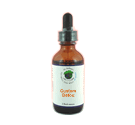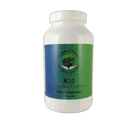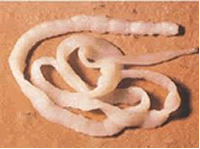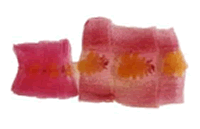|
|
Tapeworm, fish
Diphyllobothrium is a genus of tapeworm which can cause Diphyllobothriasis in humans through consumption of raw or undercooked fish. It is also known as the salmon tapeworm or broad fish tapeworm.
Adult tapeworms may infect humans, canids, felines, bears, pinnipeds, and mustelids, though the accuracy of the records for some of the nonhuman species is disputed. Immature eggs are passed in feces of the mammal host (the definitive host, where the worms reproduce). After ingestion by a suitable freshwater crustacean such as a copepod (the first intermediate host), the coracidia develop into procercoid larvae. Following ingestion of the copepod by a suitable second intermediate host, typically a minnow or other small freshwater fish, the procercoid larvae are released from the crustacean and migrate into the fish's flesh where they develop into a plerocercoid larvae (sparganum). The plerocercoid larvae are the infective stage for the definitive host (including humans).
Because humans do not generally eat undercooked minnows and similar small freshwater fish, these do not represent an important source of infection. However, these small second intermediate hosts can be eaten by larger predator species, for example, trout, perch, and walleyed pike. In this case, the sparganum can migrate to the musculature of the larger predator fish. Mammals (humans) can acquire the disease by eating the infected fish raw or undercooked.
After ingestion of the infected fish, the plerocercoids develop into immature adults and then into mature adult tapeworms which will reside in the small intestine. The adults attach to the intestinal mucosa by means of the two bilateral grooves (bothria) of their scolex. The adults can reach more than 10 m (up to 30 ft) in length in some species such as D. latum, with more than 3,000 proglottids. One or several of the tape-like proglottid segments (hence the name tape-worm, interesting that the segments, seen in photo, also resemble sushi -YUM) regularly detach from the main body of the worm and release immature eggs in fresh water to start the cycle over again. Immature eggs are discharged from the proglottids (up to 1,000,000 eggs per day per worm) and are passed in the feces.
Symptoms are generally mild and can include diarrhea, abdominal pain, vomiting, weight loss, fatigue, constipation and discomfort. Approximately four out of five cases are asymptomatic and can go many years without being detected. In a small number of cases, this leads to severe vitamin B12 deficiency due to the parasite absorbing 80% or more of the host's B12 intake and a megaloblastic anemia indistinguishable from pernicious anemia. The anemia can also lead to subtle demyelinative neurological symptoms (subacute combined degeneration of spinal cord). Infection for many years is ordinarily required to deplete the human body of vitamin B-12 to the point that neurological symptoms appear.
|
|
| |
Tapeworm, fish Detox Remedy
Detoxification of all Tapeworm, fish and related toxins
$14.95
Read/Write Reviews
|
 Add
To Cart Add
To Cart |
 |
 |
IC-2
The natural alternative to pepto-bismol.
$19.95
|
 Add
To Cart Add
To Cart |
 |
 |
Digestive Aid-out of stock
Use with all meals for best digestion.
$32.90
|
 Add
To Cart Add
To Cart |
 |
 |
|
|
 Arthropod/Vector
Bacteria
Chemicals
Fungus /Mold
/ Yeast Metals Parasites Virus Other
Arthropod/Vector
Bacteria
Chemicals
Fungus /Mold
/ Yeast Metals Parasites Virus Other





